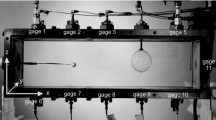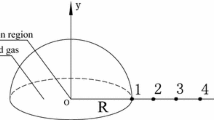Abstract
A gas explosion accident is often followed by a serious fire. In order to effectively prevent fire induced by a gas explosion accident, it is necessary to have some knowledge of the related explosion processes. The subject of the present study is to examine deflagration behaviors beyond the original cloud of the ethyne–air mixture and the fireball size in an ethyne–air explosion by means of numerical simulations. The explosion overpressure, flow velocity, and reaction rate distribution in an ethyne–air explosion are obtained. The peak explosion overpressure is found to reach its maximum beyond the original cloud for ethyne–air mixtures with ethyne concentrations greater than 13% (by volume). The explosion pressures beyond the original cloud may be higher than those within the cloud for these ethyne–air mixtures. The ratio of the combustion range to that of the original cloud is 1.4–2.7 in the radial direction on the ground and 1.5–4.0 along the axis of symmetry perpendicular to the ground.
Similar content being viewed by others
References
M. R. Baer, R. J. Gross, J. W. Nunziato, and E. A. Igel, “Experimental and Theoretical Study of Deflagrationto- Detonation Transition (DDT) in the Granular Explosive,” Combust. Flame 65 (1), 15–30 (1986).
D. A. Kessler, V. N. Gamezo, and E. S. Oran, “Simulations of Flame Acceleration and Deflagration-to- Detonation Transitions in Ethyne–Air Systems,” Combust. Flame 157 (1), 2063–2077 (2010).
S. M. Frolov, “Acceleration of the Deflagration-to- Detonation Transition in Gases: From Shchelkin to Our Days,” Fiz. Goreniya Vzryva 48 (3), 13–24 (2012) [Combust., Expl., Shock Waves 48 (3), 258–268 (2012)].
L. Kagan and G. Sivashinsky, “On the Transition from Deflagration to Detonation in Narrow Tubes,” Flow Turbul. Combust. 84 (1), 423–437 (2010).
P. Middha and O. R. Hansen, “Predicting Deflagration to Detonation Transition in Hydrogen Explosions,” Process Saf. Prog. 27 (3), 192–204 (2008).
Q. Zhang, B. Qin, and D. C. Lin, “Estimation of Pressure Distribution for Shock Wave through the Bend of Bend Laneway,” Saf. Sci. 48 (1), 1263–1268 (2010).
Q. Zhang, B. Qin, and D. C. Lin, “Estimation of Pressure Distribution for Shock Wave through the Junction of Branch Gallery,” Saf. Sci. 57, 214–222 (2013).
Q. Zhang, L. Pang, and H. M. Liang, “Effect of Scale on the Explosion of Methane in Air and Its Shock Wave,” J. Loss Prev. Process Ind. 24 (1), 43–48 (2011).
Q. Zhang, L. Pang, and S. X. Zhang, “Effect of Scale on Flame Speeds of Methane–Air,” J. Loss Prevention Process Ind. 24 (5), 705–712 (2011).
Q. Zhang and L. Pang, “Flame and Temperature Wave Propagation Characteristic of Methane–Air Mixture in Mine Tunnels,” Int. J. Numer. Methods Heat Fluid Flow 23 (5), 885–898 (2013).
H. Akinori and M. Akiko, “Numerical Analysis of Gas Explosion Inside Two Rooms Connected by Ducts,” J. Loss Prev. Process Ind. 20 (4), 455–461 (2007).
Y. D. Jo and D. A. Crowl, “Flame Growth Model for Confined Gas Explosion,” Process Saf. Prog. 28 (2), 141–146 (2009).
S. Marc, G. Andreas, and K. Ulrich, “Experiments on the Influence of Pre-Ignition Turbulence on Vented Gas and Dust Explosions,” J. Loss Prev. Process Ind. 19 (2), 194–199 (2006).
R. K. Zipf (Jr.) et al., “Ethyne–Air Detonation Experiments at NIOSH Lake Lynn Laboratory,” J. Loss Prev. Process Ind. 26 (2), 295–301 (2013).
E. Salzano, F. S. Marra, G. Russo, and J. H. S. Lee, “Numerical Simulation of Turbulent Gas Flames in Tubes,” J. Hazard. Mater. 95 (3), 233–247 (2002).
S. A. Zhdan, “Analysis of the Explosion of Gas Mixtures with a Shift in the Chemical Equilibrium of the Products Taken into Account,” Fiz. Goreniya Vzryva 19 (1), 131–134 (1983) [Combust., Expl., Shock Waves 19 (1), 124–127 (1983)].
S. A. Zhdan, “Calculation of the explosion of a Gaseous Spherical Charge in Air,” Prikl. Mekh. Tekh. Fiz. 16 (6), 69–74 (1975) [J. Appl. Mech. Tech. Phys. 16 (6), 893–896 (1975)].
V. Novozhilov, “Some Aspects of the Mathematical Modelling of Fireballs,” Proc. Inst. Mech. Eng., E: J. Process Mech. Eng. 217 (2), 103–119 (2003).
G. Yang, X. Ding, M. Bi, and A. Abuliti, “Experimental and Simulation Study of the Effect of Fuel Concentration on Flammable Vapor Cloud Explosion,” Acta Petrolei Sinica (in Chinese) 20 (5), 553–558 (2004).
Author information
Authors and Affiliations
Additional information
Original Russian Text © Y. Huang, Q. Zhang, H. Yan, W. Gao.
Rights and permissions
About this article
Cite this article
Huang, Y., Zhang, Q., Yan, H. et al. Estimation of the Fireball Size in an Ethyne–Air Cloud Explosion. Combust Explos Shock Waves 54, 106–112 (2018). https://doi.org/10.1134/S001050821801015X
Received:
Revised:
Published:
Issue Date:
DOI: https://doi.org/10.1134/S001050821801015X




